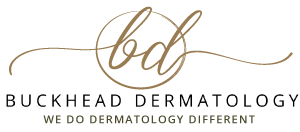What are Razor Bumps?
It is not uncommon for anyone who removes their body hair with a razor to develop small, red bumps on the surface of their skin soon after shaving. Razor bumps are usually nothing to worry about and will go away on their own. However, for those who experience chronic razor bumps and ingrown hairs, it is much more than a minor irritation. At Buckhead Dermatology in Atlanta, we specialize in educating our patients on preventing razor bumps and treating those who are battling with painful, infected ingrown hairs.
Razor bumps typically appear as small, raised and red bumps that closely resemble pimples. Often, a hair or even pus can be visible inside the bump. Ingrown hairs can be painful and itchy, and if left untreated, can become infected. One of the best ways to prevent ingrown hairs is to develop a better understanding of how they develop in the first place.
Everyone has experienced dry skin at some point in their lives. For those who live in dry climates, it may be a daily concern. Although dry skin is not a serious skin condition for most people, it can cause some discomfort and even embarrassment for those who experience more severe cases. Very dry skin that has a white or gray appearance is often referred to as ashy skin.
The Causes of Razor Bumps and Ingrown Hairs
Human hair usually extends out from the hair follicle and away from the skin. When the hair does not grow out from the follicle in the typical fashion, it can cause irritation. Some of the most common causes of razor bumps are shaving and other hair removal methods such as waxing and threading. Shaving can often cut the hair at an angle and too close to the skin, causing the hair to become trapped underneath the surface. The trapped hair begins to grow downward or sideways under the skin resulting in the unwanted red bumps. Razor bumps can be found anywhere on the body where the hair is removed, including the face, neck, legs, armpits and bikini line.
Ingrown hairs can also be caused by clogged hair follicles that disrupt the normal growth and direction of the hair. However, ingrown hairs can be caused by other factors such as tight clothing and genetics. People who have very curly or coarse hair tend to experience higher rates of ingrown hairs. This kind of hair is more prone to curling back beneath the skin’s surface.
Did you know that there are two types of razor bumps?
Extrafollicular Razor Bumps: Generally caused when a hair is cut close to the surface. The hair becomes sharp at the cut and bends back into the skin’s surface, where it grows downward, causing inflammation. A small portion of the hair may be visible in this type of razor bump.
Transfollicular Razor Bumps: Occurs when the hair does not extend beyond the surface of the skin. The hair will curve under the skin and begin to grow downward, causing inflammation. This type of razor bump is commonly caused by pulling the skin taut while shaving or tweezing hair.
Who Can Get Razor Bumps and Ingrown Hairs?
Anyone can get razor bumps and ingrown hairs. However, those who frequently shave their face and neck have a higher likelihood of developing razor bumps. The American Osteopathic College of Dermatology reports that razor bumps commonly occur in up to 60% of African American males. Other statistics indicate that the percentage may be closer to 80%. In general, men and women with curly hair are more prone to razor bumps and ingrown hairs.
How to Prevent Ingrown Hairs
- Before shaving, dampen the skin with warm water and a gentle soap to clean and open the pores.
- Exfoliate the skin using a brush, washrag or products that contain retinols, salicylic acid or glycolic acid.
- Use a high-lather shaving gel or cream to soften the hair and reduce friction.
- Do not shave or use other hair removal methods daily.
- Shave in the direction of hair growth, not against it.
- Always use clean tools.
- Never use dull or old razors when shaving.
How to Treat Ingrown Hairs
If you are experiencing razor bumps or ingrown hairs, avoid the urge to remove the hair on your own. The likelihood of infection rises when patients use non-sterile tools such as dirty tweezers or needles. Multiple attempts at removing a hair can cause damage to the skin and can even leave scarring. Consult with a dermatologist immediately if you see signs of an infection, including:
- Swelling
- Redness
- Pain
- Fever
- Pus
- Warmth
At the first sign of razor bumps, stop shaving and using other hair removal methods right away. Avoid tight clothing that may cause further irritation to the area. If the razor bump or ingrown hair does not begin to heal on its own, it may be time to contact your dermatologist. Your doctor may prescribe a number of treatments depending on the severity of the issue. Common treatments for ingrown hairs may include:
- Topical Steroid Creams to reduce inflammation and soothe itchiness and irritation.
- Prescription Retinoid Creams to boost skin exfoliation.
- Topical Chemical Exfoliators to aid in removing dead skin.
- Antibiotics may be required if there is an infection.
- Laser Hair Removal for those who experience frequent and severe razor bumps or ingrown hairs.
